Video consumption is growing exponentially and shows no signs of slowing. Out of the various types of content, video has evolved into the dominant force of today’s digital landscape, offering an immersive experience for all audiences.
It’s understandable why video marketing is now an essential component of a brand’s marketing strategy rather than an optional tactic. Research shows video marketing is one of the most effective tools for engaging target audiences, with HubSpot highlighting, “Video has the highest ROI of any media format by far, followed by images, blog posts, and podcasts or other audio content.”
Video marketing is a dynamic medium that combines audio, visual, and motion graphics to create various advertising messages. However, its main capabilities extend far beyond that.
According to a report from Wyzowl, 91% of businesses employ video as a marketing tactic. Moreover, “The highest ever proportion of marketers (96%) continue to value video as an ‘important part’ of their marketing strategy.” These numbers reveal the strong impact video marketing has on business growth.
But what exactly makes video marketing so powerful? And how can you incorporate it into your growth strategy to achieve high results? To answer these questions, we’ll discuss the key growth-driving attributes of video marketing and how you can use them to your advantage.
Understanding the Growth Mechanics Behind Video Marketing
Video marketing can foster growth no matter your company’s budget, size, industry, or target audience. Moreover, it encourages success in campaigns targeting the various stages of your buyer’s journey. Video marketing has unique attributes that give it an edge over other forms of content. We’ve grouped these based on three main outcomes they contribute to. Let’s take them one by one.
→ Brand awareness and recognition
HubSpot reports “36% of marketers say the primary goal of their company’s video marketing efforts is to increase brand awareness and reach new audiences.” In other words, companies use video marketing to:
- Build a strong brand image
- Expand their outreach and eliminate communication boundaries
- Connect with different audiences and geographies
- Gain recognition among other brands
These actions are possible thanks to the unique capabilities exclusive to this medium, including:
DISCOVERABILITY
Video SEO (search engine optimization) refers to optimizing your video content for easier discovery. It involves technical and creative elements such as:
- Naming: Your video title should be relevant to your audience and express what they’re searching for. It also has to be descriptive to help search engines understand what your video is about.
- File optimization: In some cases, you can optimize the size of your videos to improve page load speed.
- Transcriptions: Adding a transcript to your videos will improve their discoverability.
- Metadata: Each video should include relevant keywords, titles, meta descriptions, and tags. All these elements are necessary to improve video ranking in search results.
Your videos may be highly relevant to and exciting for your audiences. However, you also need to optimize the content for search engines to increase their visibility and attract organic traffic.
SHAREABILITY
Wyzowl’s report highlights that “51% of people are more likely to share video with their friends than any other type of content, making video comfortably the most ‘shareable’ type of online content.”
This comes as no surprise considering our tendency to engage based on our emotions; we enjoy sharing a good laugh or interesting insight with our peers.
Videos are rich multimedia experiences that engage multiple senses to create strong emotional connections with viewers. This emotional element drives people to share your videos with their community, increasing the potential reach of your message and brand.
VIRALITY
Rapid, widespread dissemination of video usually occurs when the message strikes a chord with its target audience on an emotional level. As a result, virality can exponentially increase your brand’s viewership as it spreads from person to person.
For example, even after almost a decade, most of us still remember Volvo Trucks’ video of Jean Claude Van Damme’s epic split.
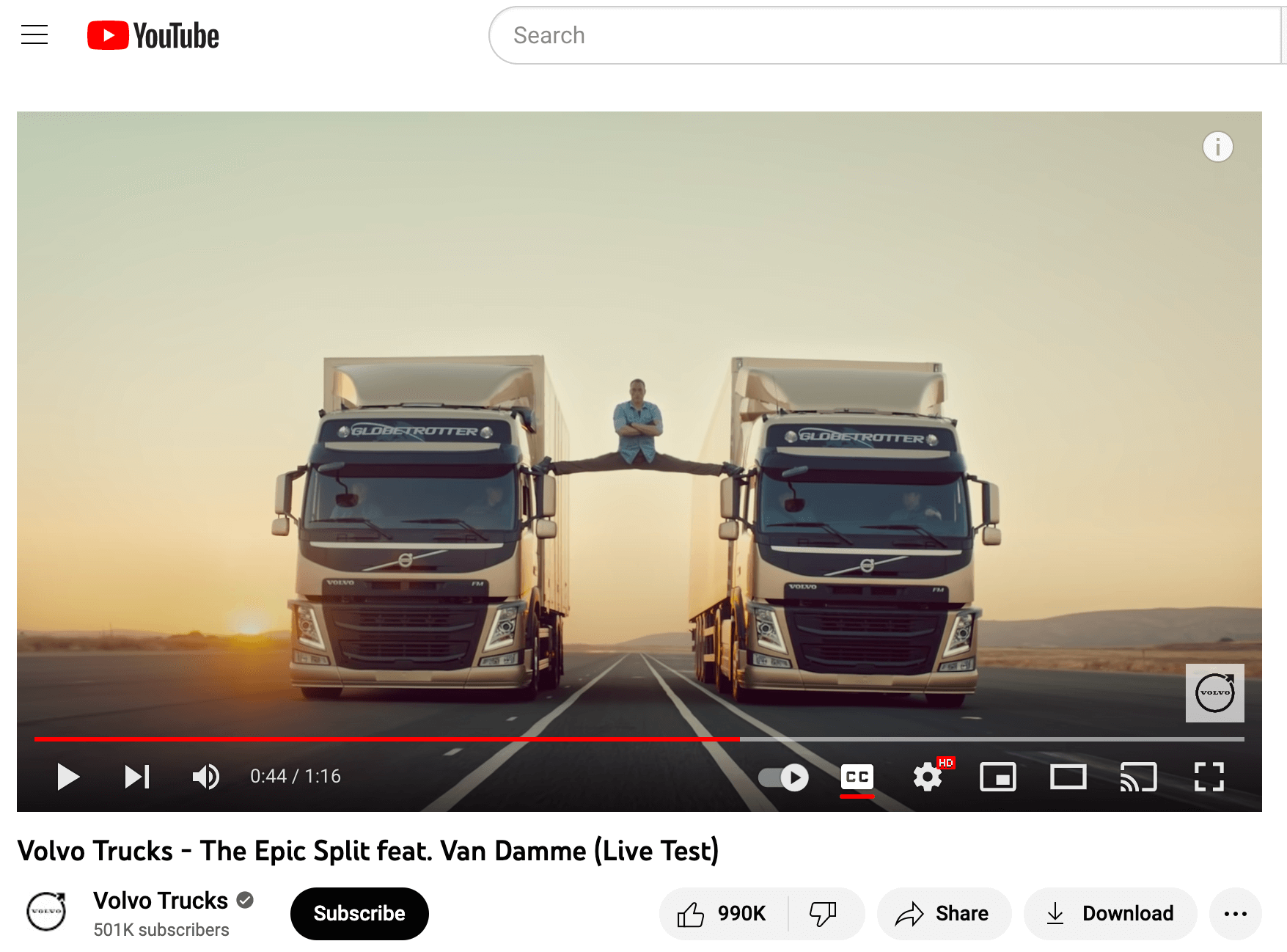
Usually, viral videos reach massive audiences quickly, transforming some brands or creators into overnight successes.
INTERNATIONALIZATION
A globalization strategy is crucial to scale and expand your brand. Your business growth depends on the capacity to adapt your messages to meet the requirements of different cultures, languages, and markets.
Video marketing applies perfectly to this goal, especially if you want to broaden your geographical outreach and engage people in their language. For example, you can use subtitle and caption generation tools to make your videos accessible to wider audiences. This then increases the reach and impact of your video marketing campaigns.
Additionally, the use of subtitles is beneficial for SEO, as your videos are more likely to rank higher in search results with them. They also make it easier for your company to operate in multiple countries.
Video SEO, shareability, and virality specifically contribute to increasing brand awareness and driving recognition. The internationalization component of video marketing also serves to make it one of the most powerful tools for scaling your brand globally.
Besides familiarizing people with your brand and products though, video marketing is also crucial to building trust and establishing long-term relationships with your audience.
→ Trust and emotional connections
Video marketing accomplishes so much more than simply communicating a message. The wide variety of video formats and contexts allows companies to:
- Cultivate a wide range of brand-associated emotions
- Connect with leads through shared values
- Build brand affinity
- Produce positive reactions and engagement
Let’s turn to the emotional aspects of video marketing.
HUMANIZING
HubSpot’s recent research found marketers are interested in humanizing their brands. Moreover, “30% of marketers are currently creating content that reflects their brand’s values, making it the third most popular trend right now.” While there are multiple ways professionals can achieve this, video marketing is the only method that helps you put a face on your brand.
Consider having your CS rep host a webinar, your SDR make a product demo, or your marketing team having fun on TikTok. You could also invite your customers to talk about your product in a Success Story interview.
These people are an important part of your brand, and video marketing allows you to place them front and center, celebrating everyone who contributes to your mission.
RELATABILITY
Relatability is the quality of being easy to understand and have sympathy for. Although written (articles, reports) and audio (podcasts) content is essential for your brand’s growth, no format else promotes relatability like video.
Apart from giving a face to your brand name as we discussed previously, video marketing includes image and voice elements that foster an emotional connection between the content and its viewer. They help your message resonate with your audience by introducing emotions and authenticity into your brand’s narrative.
IMMERSION
Video marketing is the most immersive form of content. What makes it so engaging? For one, video marketing is usually based on storytelling. Attention-grabbing and addictive, stories are highly efficient at conveying messages in compelling ways.
Stories help clarify and solidify abstract concepts and ideas, transforming them into clear, concise messages our minds can comprehend. They also yield greater engagement and transform video consumption into an authentic experience. Thanks to their immersive nature, your audience will develop a sense of familiarity and ease each time they see your brand.
VULNERABILITY
Finally, video marketing enables brands to be authentic and raw about their processes. An example of this can be seen in “Onboarding Joei,” a docu-series by learning management platform 360Learning. The series offers an unscripted glimpse into the life of Joei Chan as she begins her journey as a content director at 360Learning. This show displays the company’s commitment to transparency and vulnerability, providing audiences with an inside look at its processes.
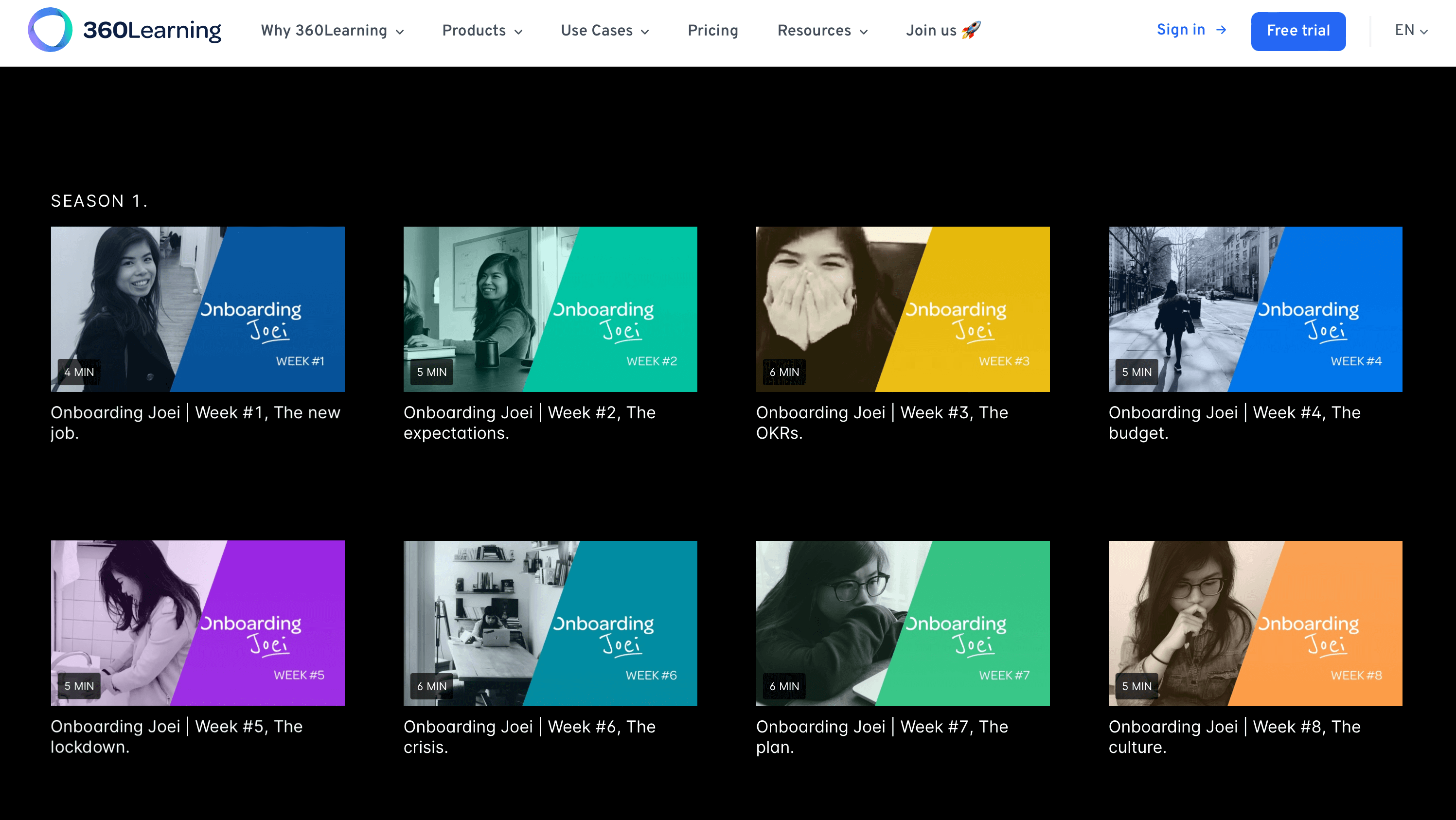
These emotion-based attributes enable video marketing to sow meaningful connections between companies and their audiences and, in turn, deepen people’s trust in specific brands. Subsequently, these long-term relationships translate into valuable business results.
→ Conversations and ongoing engagement
Video marketing ignites conversations and ensures ongoing interactions between people and your brand. Different video marketing formats excel at facilitating real-time engagement, allowing companies to:
- Showcase brand expertise
- Gain industry authority
- Entertain real-time conversations
- Strengthen their audience connections
The characteristics that further these aims are as follows.
REAL-TIME INTERACTION
Whether it’s a live stream, webinar, or virtual/hybrid event, video can spark live, engaging conversations with your audience. No other content format provides the ease of interaction via live chat or bringing someone “on stage.” This human connection and real-time knowledge exchange encourage a long-lasting relationship between people and your brand.
ENTERTAINING
Video marketing provides an opportunity to blend education and entertainment seamlessly. Get creative with your videos and combine humor with complex topics. For example, Webflow is transforming its educational videos into delightful comedy sketches.

Entertaining videos are more shareable and relatable. As a result, they amount to a higher number of views, gradually establishing brand authority on educational topics.
TRANSFORMATIVE
Video marketing can have a profound impact on viewers. Companies can alter people’s perceptions about specific topics through captivating visuals, sounds, and storytelling. Sometimes, videos can even improve certain aspects of people’s lives.
For example, video series such as “Your Design Career” or “Inside Marketing Design” by Webflow can be highly transformative for future designers.
By creating engrossing and informative videos, you’ll showcase your company’s expertise, keep the conversation going, and, in some cases, contribute to building a full-fledged community around your brand.
Support People Every Step of the Way
Another major advantage of video marketing is that you can employ it at all touch points and stages in your buyer’s journey. In other words, your marketing, sales, and Customer Success (CS) teams can benefit and derive great results from video marketing.
→ MARKETING
Your marketing team can use videos to:
- Drive traffic to your website
- Generate high-quality leads
- Move leads through the pipeline
Your marketing managers can nurture top-of-funnel leads by offering webinars or event recordings on demand. They can also attract mid-funnel leads by publishing gated success story interviews. Lastly, they can entice bottom-of-funnel leads by creating a gated demo for people interested in learning more about your product.
Videos significantly help your marketing team move leads through the pipeline.
As an example, if you have free trial users, you can prepare video onboarding materials to help them navigate your platform and transform them from low-interest newbies into powerhouse users who’ll subsequently purchase a plan.
→ SALES
Your sales team can leverage videos to:
- Engage with outbound prospects
- Transform prospects into customers
Your company’s sales reps can take advantage of video content to personalize their outbound email sequences. They can also build customized presentations and demos and detailed case studies and use cases. And, although videos may not contribute directly to closing a deal, they definitely influence your prospects’ buying decisions.
→ CUSTOMER SUCCESS
Videos help your CS team:
- Educate customers, ensuring their success
- Cross-sell or upsell your products
This format is great for showing customers how to achieve desired results with your offering. These materials can reduce your churn rate and build loyalty, transforming customers into brand ambassadors. For example, your CS team could regularly publish tutorials, Q&A sessions, live streams, and behind-the-scenes content.
Making these videos exclusive to your community members will strengthen their connection with your brand and elevate your customer relationship strategy.
Essential Aspects of Video Production
Before listing the types of video marketing, let’s discuss certain video production characteristics. This will help you understand the various aspects of creating new videos for your business.
→ Content style
There are two types of videos you can produce:
- Live: Video content that’s broadcasted and streamed live at the same time as it’s being recorded. Your audience can watch these videos and interact with your brand’s representatives through comments or chat in real time. You can use live videos in various contexts, including product demonstrations, behind-the-scenes events, Q&A sessions, tutorials, and more. They offer immediacy and authenticity that can engage audiences in a way that pre-recorded videos may not.
- Pre-recorded: These videos are recorded and saved before they’re slated for viewing. You can use them at a later date for advertising, education, entertainment, or some other purpose. Unlike live videos, recordings provide more control over the final product, including editing, re-shooting, and post-production effects.
→ Narrative
When producing videos, you can choose between two content styles:
- Scripted: This concept refers to videos with a written script outlining the video’s dialogue, actions, and scenes. The script serves as a blueprint for the video production process, ensuring all elements are planned and executed in a uniform and organized manner. You can script both your live and pre-recorded videos.
- Unscripted: These videos are often spontaneous, unplanned, and off the cuff, relying on natural engagement instead. They’re usually shot live and excel at capturing candid moments, creating a more authentic feel, and lending a sense of immediacy to the content.
→ Production level
There are three levels of video production, which depend greatly on your goals and resources:
- Low-level production requires basic skills and usually involves a small amount of equipment. In some cases, a smartphone camera is enough.
- Medium-level production entails more planning and resources than low-level production. It typically uses professional equipment, such as high-quality cameras, lighting, and sound recording equipment.
- High-level production refers to videos with high-quality values, focusing on visuals, sound, and special effects. This type of production usually requires a bigger budget, a larger production team, and more advanced equipment, such as professional cameras, lighting, sound equipment, and post-production software.
→ Length
Different goals and sharing platforms will dictate the length of your videos. You can choose between three options:
- Short-form videos range from 10 seconds to two minutes. As HubSpot asserts, “Not only is short-form video the most popular trend among marketers, with one-third using it, but it’s also the most effective and has the highest ROI.”
- Medium-form videos are between five and 30 minutes.
- Long-form videos are usually longer than 30 minutes.
Although not exhaustive, the above production-related criteria are crucial elements you need to consider before building your video marketing strategy.

DOWNLOAD YOUR FREE WEBINAR STRATEGY CHECKLIST BELOW 
Use this checklist 
We promise to never spam or send emails about cats.
Okay, maybe some cat stuff.
Types of Video Marketing
From a 10-second TikTok video to hours-long virtual event recordings, there’s no shortage of video content your company can use. The types you choose depend on your goals, target demographics, and available resources. With this mind, here’s a quick list of video formats your brand should consider adopting to reach and exceed your objectives:
→ Social media videos
Social media videos should accompany your marketing team’s efforts, as they help connect with your target audience on platforms where they spend most of their time.
As HubSpot highlights, “Social media is used for video sharing by 76% of video marketers and has the biggest ROI of any video marketing channel, by far. It is also the most effective channel for generating leads from marketing videos.”
You can create social media videos to:
- Give your brand a face
- Build trust
- Drive traffic to your website
- Tell stories
- Showcase your product
- Share your expertise
- Engage your network
- Build a sense of community
- Sell products (for example, via Instagram Shopping)
You’ll have the opportunity to choose between multiple formats, as the right ones will depend on the platform where you want to share your content. This also holds true for the content length. For example, a TikTok video will be much shorter than a live stream on Instagram.
▶ Example: Marketing professionals are getting creative with video formats and platforms: Talia Shani, Director of Marketing at Yotpo, reposts the company’s TikTok videos on LinkedIn, generating lots of laughter and engagement.
→ Video ads
Video ads can take multiple shapes. From funny sketches to full product presentations, they aim to familiarize audiences with a brand’s offering. Usually, video ads are scripted and involve high-level production. For the greatest impact, they should be both informative and entertaining.
▶ Example: YouTube is rife with company ads, from Grammarly to Wix and everything in between. Basecamp, for instance, created a noteworthy video ad for its first brand campaign, “Just let me do my job.” Its clever use of humor holds viewers’ attention, making them want to see more.

→ Landing page videos
From quick demos to quirky videos nudging people to sign up, teams leverage the power of video marketing on their landing pages to extend the amount of time visitors spend there. According to Wistia, “People spent on average about 1.4x more time on pages with video than without.”
▶ Example: “You’re here! Yes!” That’s how Wistia’s landing page video starts. It then flows into a funny presentation of the product benefits.
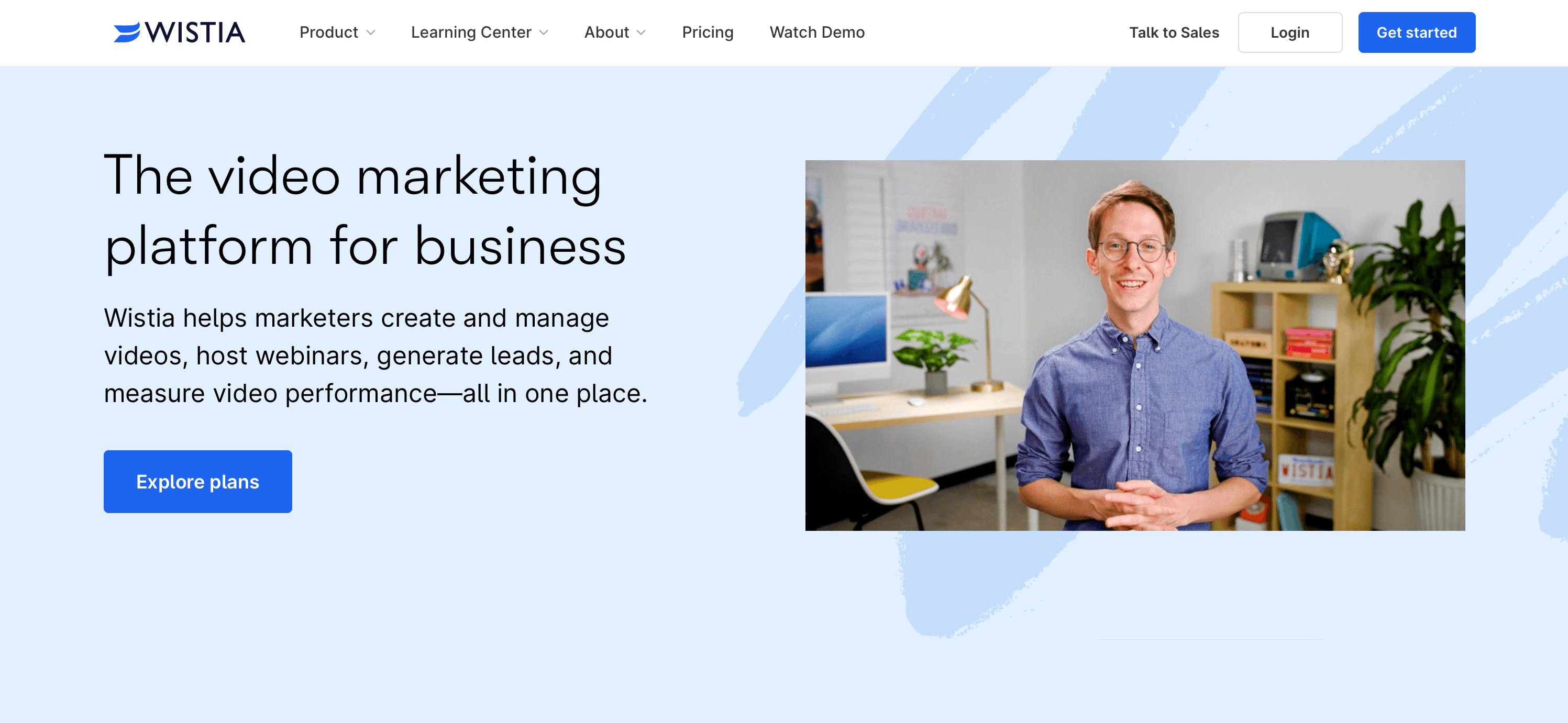
→ Short testimonials
Short testimonials feature real customers who use a company’s product or services, highlighting the benefits and value they’ve enjoyed. These videos only require low-level production as, in most cases, customers can record themselves using their smartphone or laptop camera. Testimonial videos are brief and to the point so they’re easy to watch.
Use this format to create a praise wall on your website. Additionally, you can publish them on social media platforms or other marketing channels to provide social proof and build trust with potential customers. Short testimonial videos help drive brand awareness and increase conversions, making them an essential part of your video marketing strategy. Here’s what a wall of love that includes video testimonials looks like:
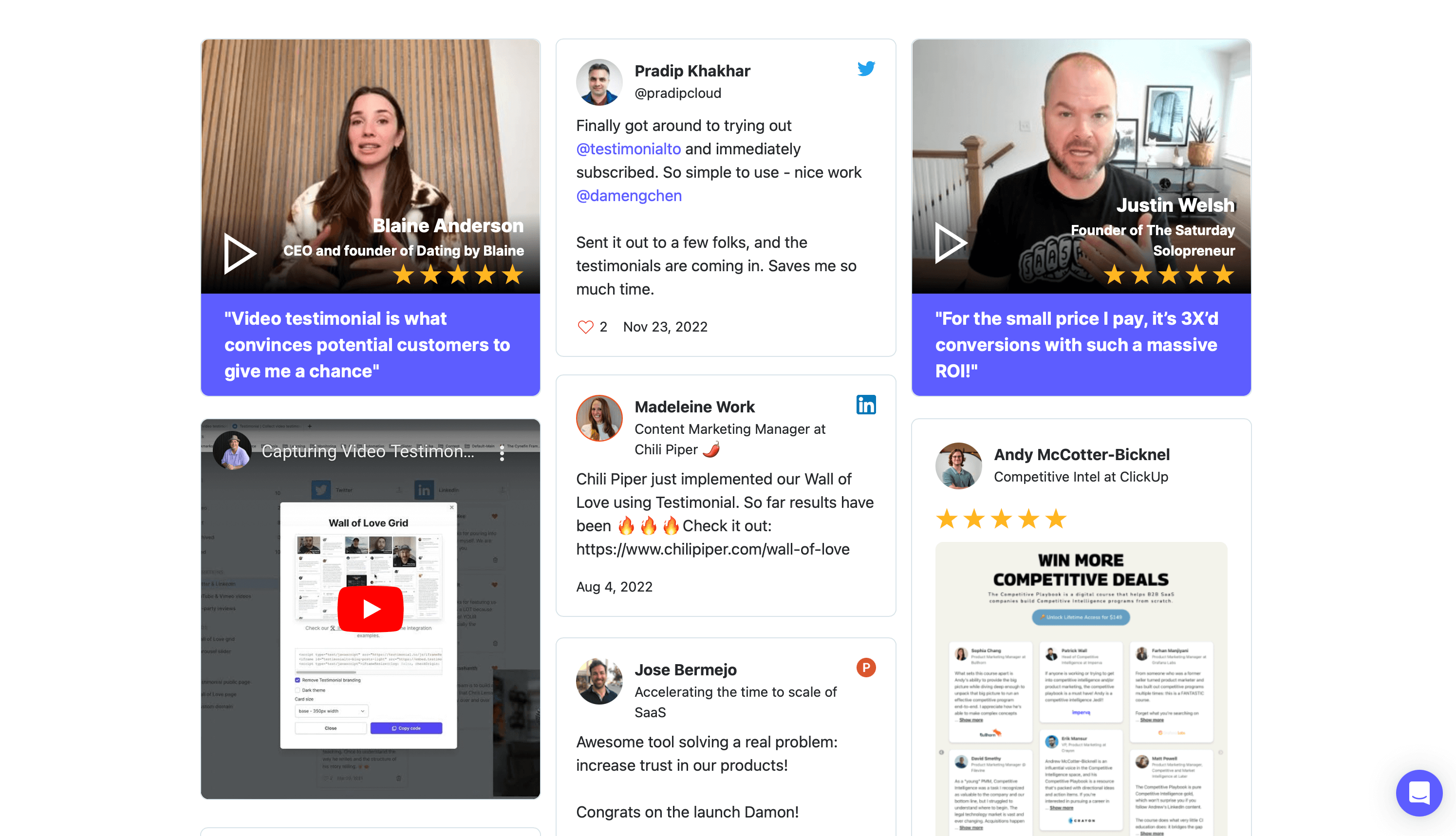
→ Customer success stories
Similar to testimonials, a Customer success story highlights the positive experiences of real customers who’ve used a company’s product or service. However, these videos are more elaborate, as they can take the form of interviews or discussions.
They showcase a product’s benefits and value and how it helps solve specific challenges. Most companies publish ungated customer success stories, while other brands gate their video production with the aim of generating bottom-of-funnel leads.
▶ Example: At Demio, we gate these videos, as they provide extra value and unique insights into our customers’ webinar strategy.
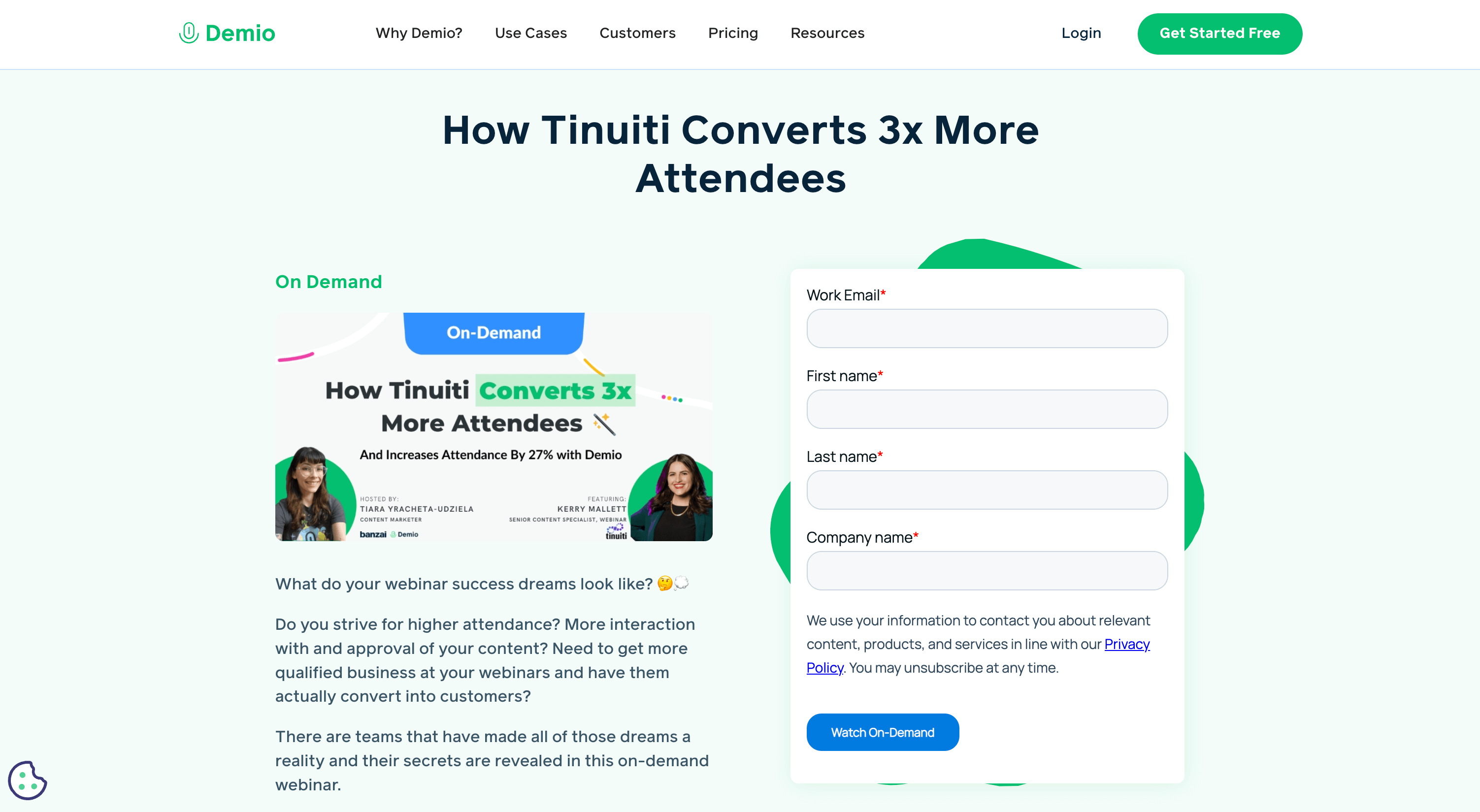
→ Video podcasts
If you have a podcast, why limit yourself to audio content only? Along with publishing the podcast on a platform such as Spotify or iTunes, you can also upload its video form on YouTube.
Whether it’s an interview or your marketing rep talking about an industry-relevant topic, seize the opportunity to create multiple formats for your content. This approach will help you expand your outreach and become visible to a broader expanse of audiences.
▶ Example: Andrew Gazdecki, founder and CEO of Acquire, runs a podcast where he interviews entrepreneurs whose businesses were acquired. Besides uploading the audio to Spotify and iTunes, Andrew also posts the interview videos on YouTube to achieve greater visibility.
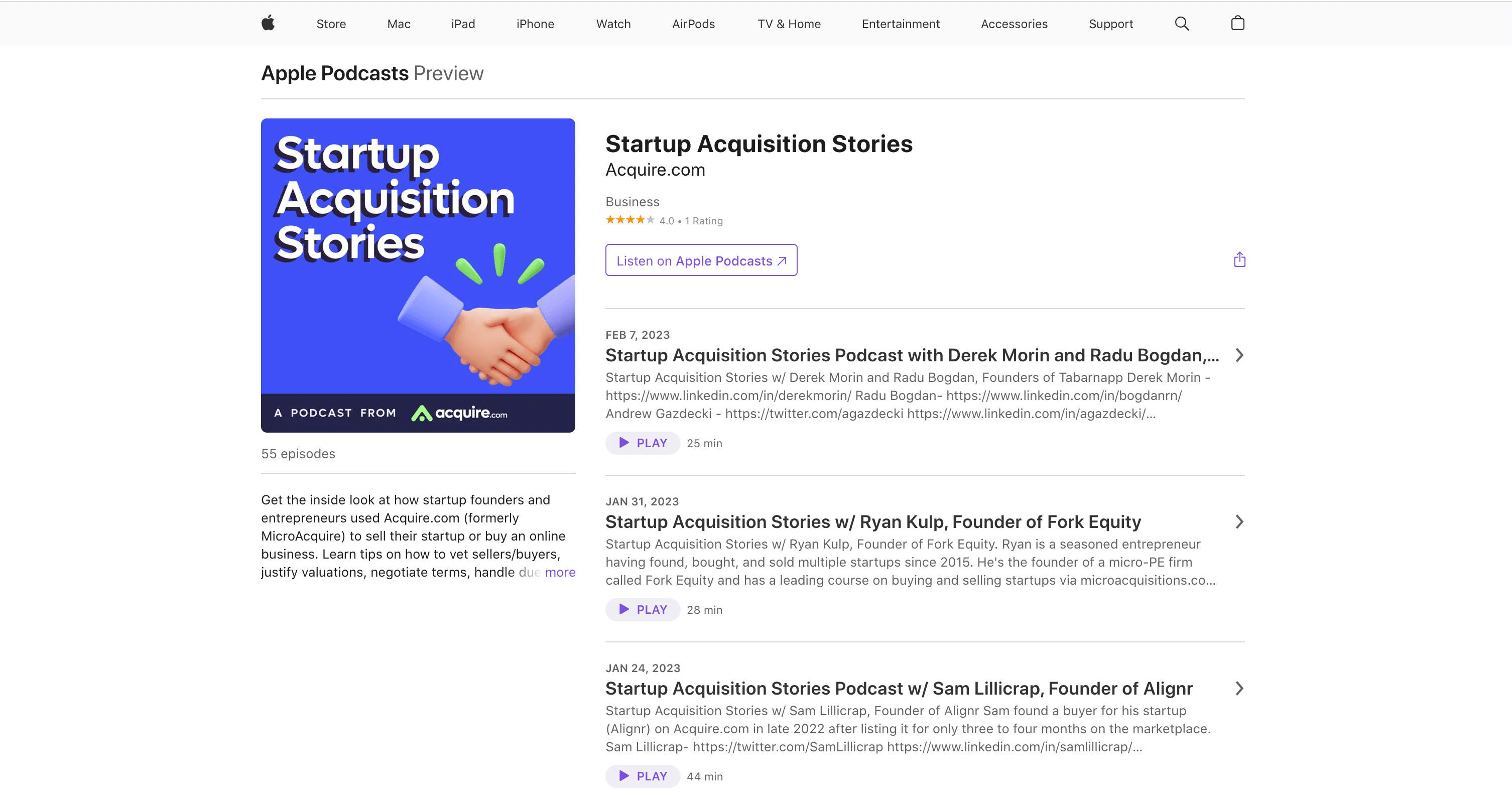
→ Product demos
Showcase your product’s features and capabilities through pre-recorded demos. You can publish them on your landing page or gate them to generate bottom-of-funnel leads. You can even include demo videos in your email sequences to spice up the traditional text-based format.
At Demio, we love webinars and use them for multiple purposes, including product demos. In Demio’s Game Show Demo, a webinar intended to showcase our platform, we focused on entertaining and engaging our audience with games and prizes. Currently, we offer this demo on demand for everyone interested in learning more about our platform.
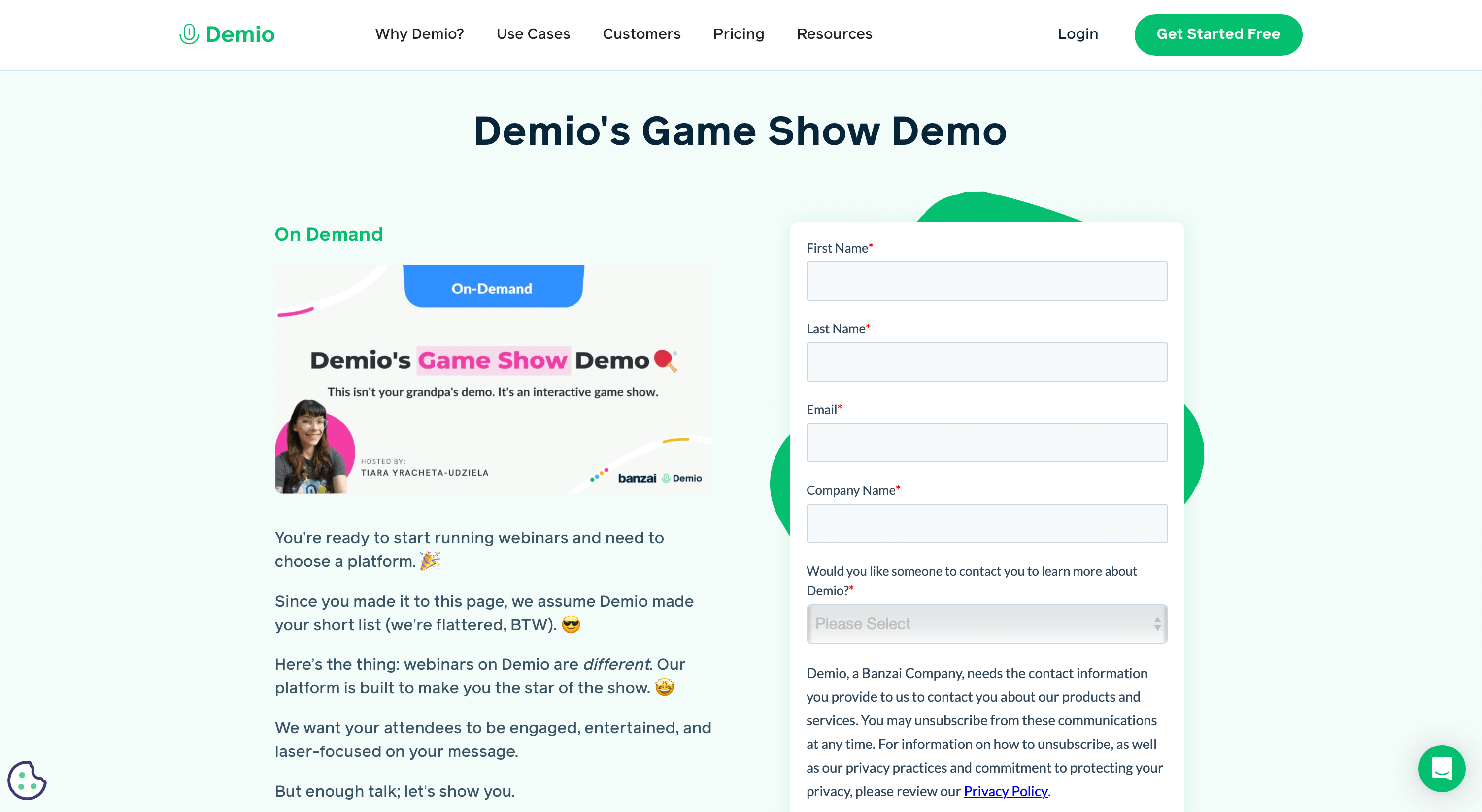
→ Webinars
Webinars are a golden asset to your outreach, conversion, and loyalty-building strategy. For one, you can run multiple types, such as recurring demo sessions or onboarding webinars. You can also leverage webinars as a platform for meaningful, industry-related conversations with thought leaders.
When employing a powerful webinar platform like Demio, you foster real-time engagement with your audience. Polls, featured actions, and handouts during events encourage audience participation, identify attendees’ intent, and conduct market research.
Moreover, you can bring attendees to the stage for even more direct interaction. Webinars harness the power of real-time conversations to build lasting relationships between attendees and hosts.
▶ Example: There’s no shortage of companies running webinars. Some brands choose to have an on/off webinar strategy, while others are consistent in their efforts, taking a systematic approach to their online events. At Banzai, we offer a wide variety of on/off recordings and webinar series, such as Beers and Webinar Fears or Banzai Battle, during which top industry leaders join us to debate the hottest topics.
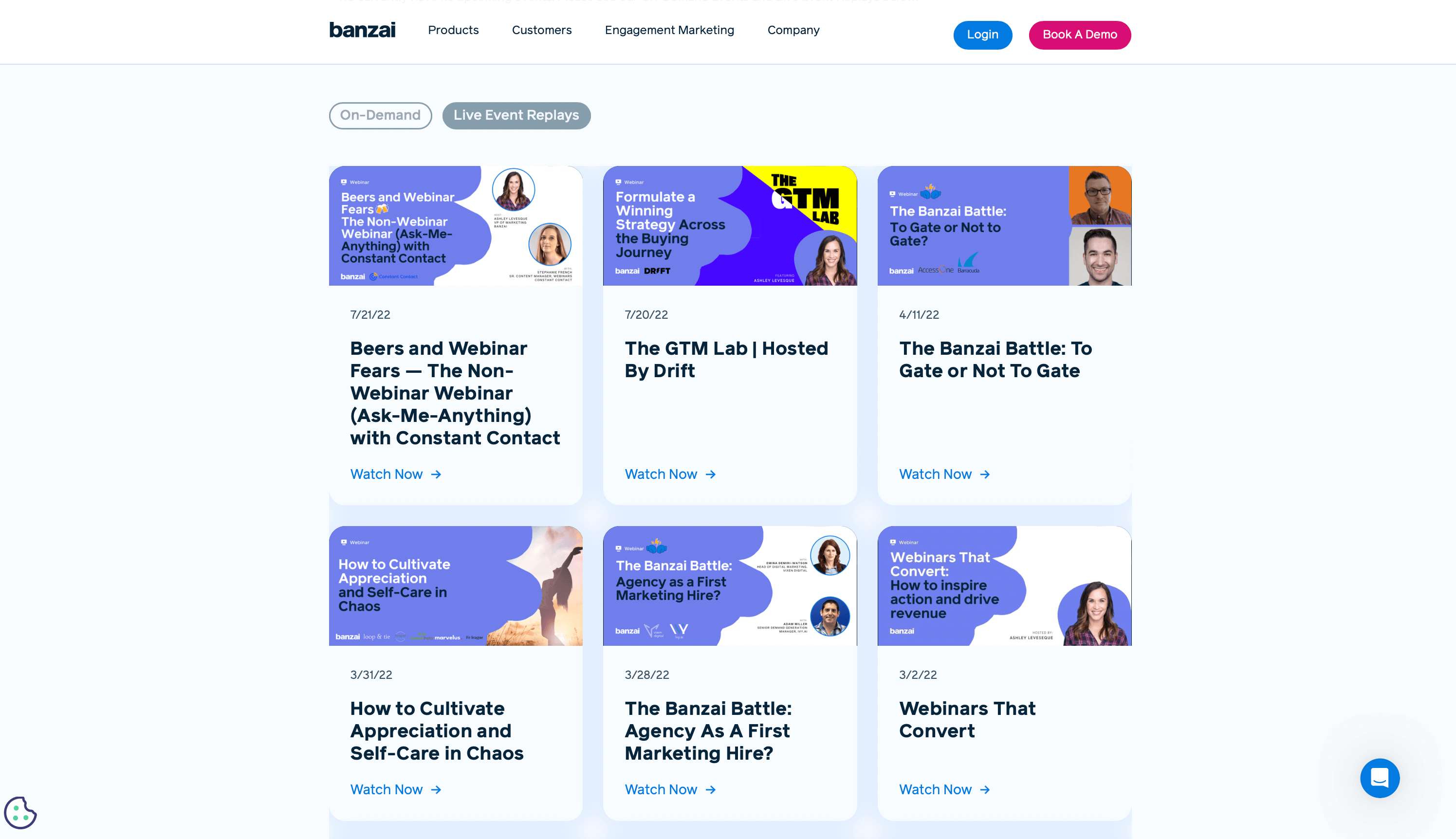
→ Live streams
Live streams are real-time video broadcasts that can accommodate an unlimited number of people. They allow businesses to make highly engaging connections with their audience, providing opportunities to showcase products, share information, and build personal links.
Live streams can take many forms, from product demos and Q&A sessions to behind-the-scenes tours and live events. Moreover, you can later offer live streams as on-demand webinars. This requires the same level of preparation, and, if you use the right webinar platform, you can ensure a high level of attendee engagement.
By approaching live streams as a type of webinar, you’ll access data and insights on your audience’s reactions and interest in your brand.
▶ Example: Sahil Lavingia, founder and CEO of Gumroad, combines YouTube live streams with the Build in Public concept by broadcasting the company’s quarterly board meetings. He peels back the curtain for Gumroad’s large audience, taking brand transparency to a new level.
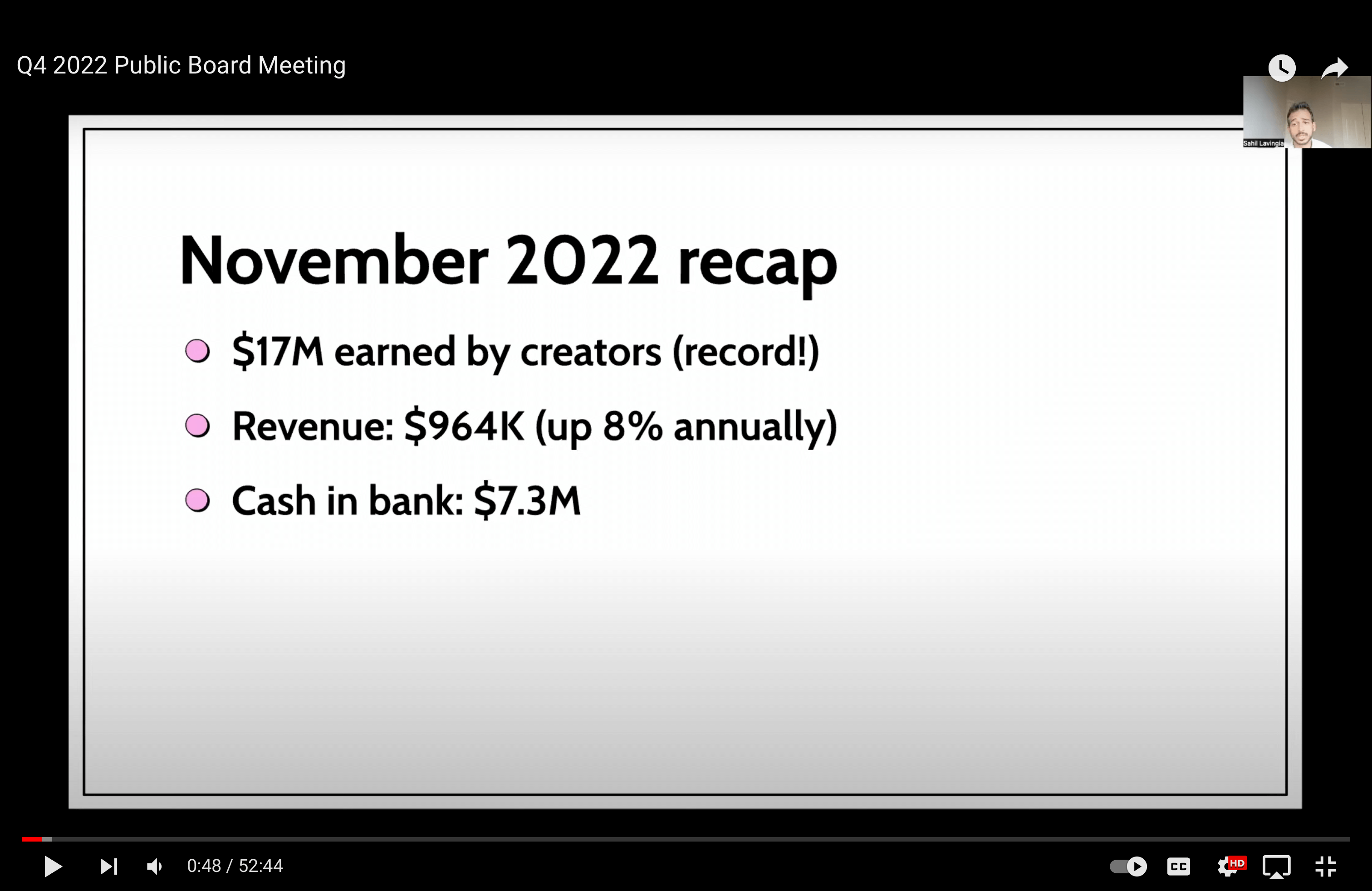
→ Onboarding videos and tutorials
Video marketing is an effective tactic for all revenue teams, CS included. These reps can take advantage of this medium by creating onboarding videos and tutorials. Both onboarding videos and tutorials are educational resources that help new users get to know a product and gain the most out of it. These videos are designed to make the learning process as frictionless as possible.
Onboarding videos and tutorials can take the form of welcome messages, step-by-step walkthroughs, animated explanations, and more. They excel at providing an overview of a product’s features and capabilities, displaying how to perform everyday tasks with it, and answering frequently asked questions.
In most cases, you can record and share these onboarding videos and tutorials. Run live, recurring webinars based on users’ knowledge level. Then, you can provide them on demand to extend their lifetime value.
Their clear, informative format increases user engagement and satisfaction rates, reduces frustration and confusion, and improves the overall experience with products, ensuring people’s success — and securing their loyalty.
▶ Example: Convertkit successfully employs in-app videos to guide new users based on the use case they want to deploy.

→ Event recordings
More and more companies are discovering the influential impact of live events and repurposing their recordings. Whether virtual or hybrid, you can record your sessions, keynote speeches, roundtables, or fireside chats and offer them on demand to generate more leads.
▶ Example: Webflow provides free access to its conference recordings. The company highlights, “The Webflow Conf opening keynote is your one-stop-shop to learn about our latest product enhancements.” People can browse through sessions on Webflow’s page and access the recordings from previous events.
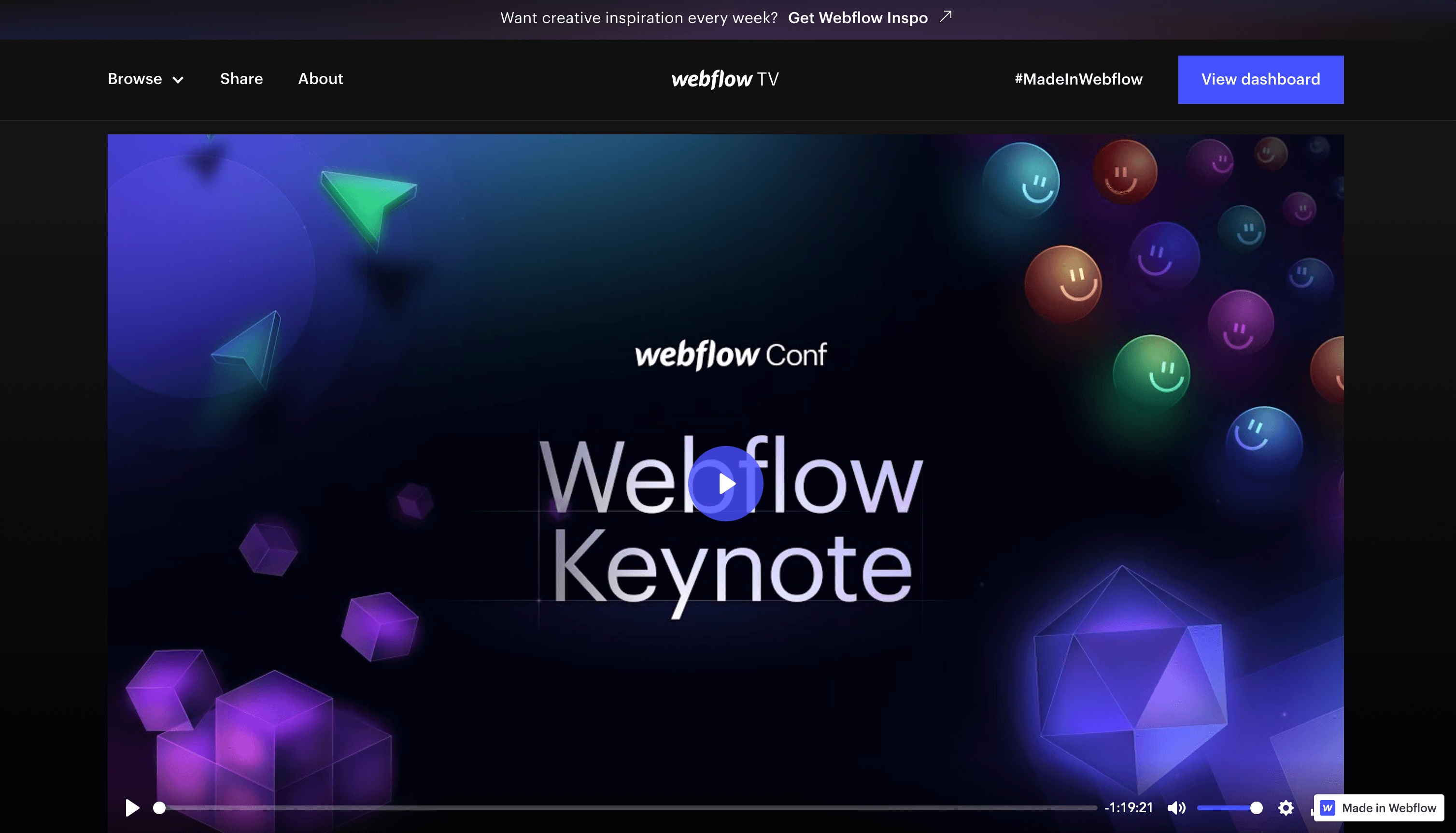
→ Movies
Some companies take video production to the next level by shooting full-fledged movies. Though expensive, this approach is excellent for increasing brand awareness and reaching a broader audience.
▶ Example: In 2019, Mailchimp officially launched Mailchimp Presents, a “business entertainment platform” focused on creating media products for and about entrepreneurs and business owners. Some reports (see IMDB budget estimates) say Mailchimp spent $6 million on its first video productions. Today, Mailchimp is publishing various unique films such as Indie Game and Memory Video.
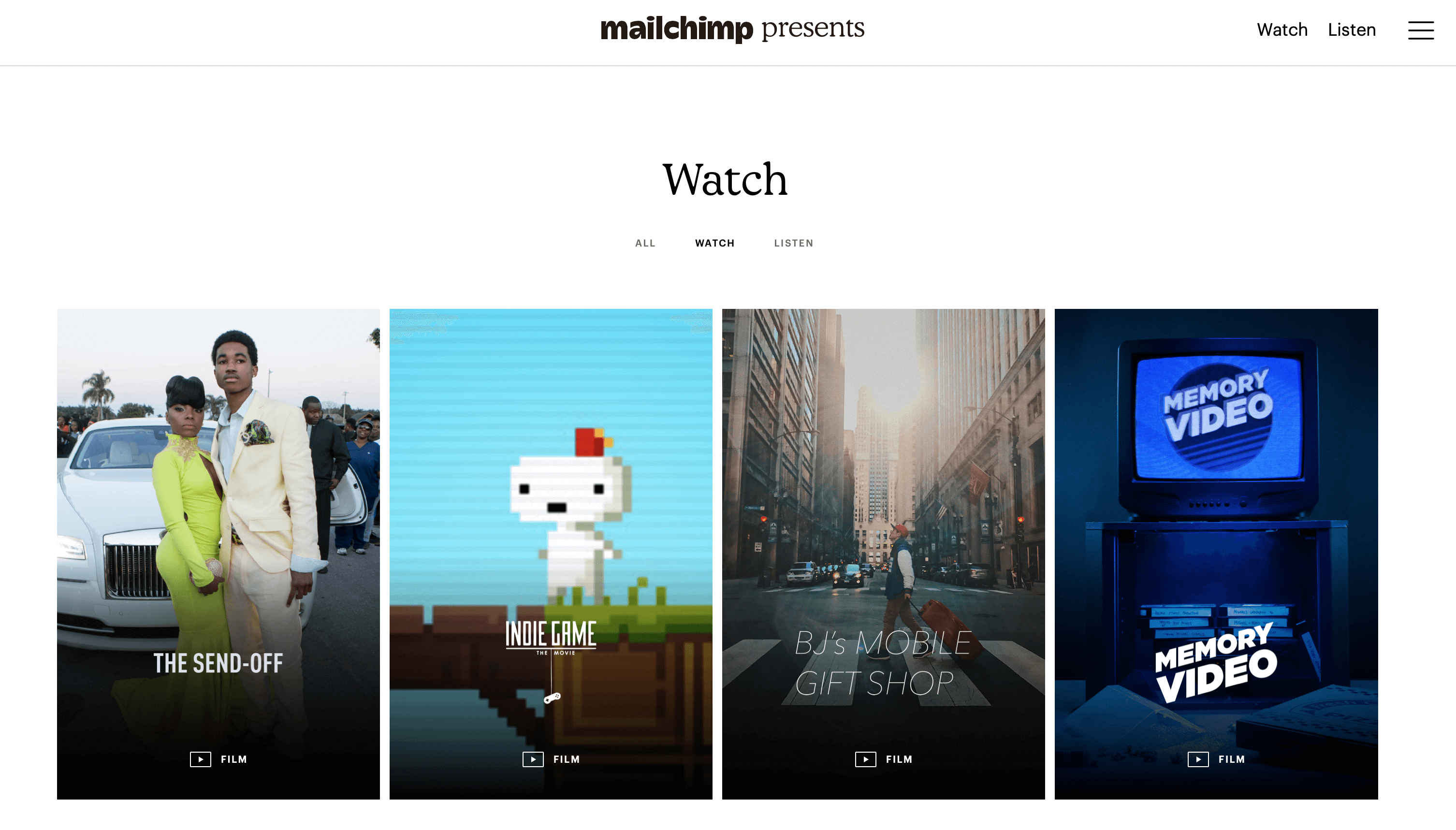
→ TV shows
To succeed in a content- and distribution-dense environment, you must find ways to differentiate yourself. Thinking like a media company has resulted in a tenfold increase in the impact of video marketing.
Media products, such as TV shows, can lean on the binging phenomenon, enticing people to interact more with your platform and brand. You won’t achieve the same reaction from a regular video. People may never come back to your platform when consuming a singular video that isn’t part of a well-produced series. However, a TV show may pique someone’s curiosity and nudge them to return to your platform to watch more.
The idea of creating a TV show may seem overwhelming. However, a simple tweak to your webinar strategy can make it work. Let’s say you’ve launched an interview-based webinar with people from your brand community. Instead of just recording the conversations, you can add a twist and include elements such as beer tasting during your session. This simple change in how you approach your interviews will help you build an identity around your webinar, gradually transforming it into a media brand. The entire idea consists in finding a small, differentiating element upon which you can develop a recurring story.
▶ Example: Companies are increasingly investing resources into developing TV shows. Here are some exciting examples:
- Learning Audrey by 360Learning: This docu-series follows Audrey as she starts from zero and works her way up to become a Learning Manager.
- Pricing Page Teardown by ProfitWell (Paddle): A weekly show where ProfitWell breaks down strategies and insights on how subscription companies can win with monetization from all market corners.
- Voice of the Product by Appcues: A season-based show focused on asking product-lead leaders eight hard-hitting questions about product-led growth.
- Generation No-Code by Webflow: A series that pulls back the curtain to tell real stories of how agencies, entrepreneurs, and creatives become empowered using no-code tools to pursue their dreams.
More prominent companies are highly active in the production of studios, full-fledged TV shows, and libraries of media products. However, smaller brands are also playing the game, creating less ambitious but nevertheless impactful media projects.
Although you may need more resources to make high-level productions or TV shows, you can still use video marketing to achieve your business goals.
How To Get Started With Video Marketing
Video marketing can be an overwhelming endeavor. After all, keeping up with so many options and approaches for integrating video into your growth strategy takes time and effort.
The good news is you can start small. To help you plant the seeds, we’ve put together a quick list of steps to follow when kicking off your video marketing project.
→ Align your video marketing goals with production capabilities
Your video marketing strategy should contribute to the company’s goals while abiding by production capacity. Perhaps you aim to increase brand awareness because your company’s new on the market. Or, maybe your OKRs highlight the need to generate more qualified leads. Knowing your desired outcomes will help you identify the right approach to your video marketing.
Apart from identifying your goals though, you must also assess your video production capacity (you can’t invest all of your resources in video marketing). Calculate the exact budget you can allocate for crafting videos. Both these pieces of information will help you determine the type of videos you can create.
As a concrete example, say your video marketing objective is to position your brand as a thought leader. However, you have limited resources and can’t invest your budget into producing an elaborate video ad. However, you can launch a series of video podcast episodes, which, apart from being cost-effective, will help you meet industry stakeholders and position your brand as an authority in your industry.
→ Define your video marketing metrics
Your goals determine your video marketing KPIs. If you want to increase brand awareness, you’ll pay attention to the number of impressions, views, and shares. To grow your pipeline meanwhile, you’d track the number of leads who accessed the recordings. If you run webinars to identify and engage people with high intent, you’ll track and analyze who:
- Downloaded your handouts
- Participated in your live polls
- Clicked on your featured actions
- Drove the conversation in your chat
These metrics will clearly display the fruits of your video marketing efforts, including their growth outcomes.

DOWNLOAD YOUR FREE WEBINAR STRATEGY CHECKLIST BELOW 
Use this checklist 
We promise to never spam or send emails about cats.
Okay, maybe some cat stuff.
→ Build your video marketing team
Based on your company’s resources, your video marketing team may comprise one person or extend to an entire department. In most cases, video production efforts are concentrated in the hands of the marketing team.
The professionals inside your company are capable of recording demo sessions, hosting webinars and events, or creating videos for TikTok. Moreover, if they’re well equipped and have access to a robust video marketing platform, they can achieve almost anything.
However, if you want to shoot videos with high production values, you may need to hire professionals for jobs such as:
- Scriptwriter: Responsible for crafting video messages that align with your brand’s narrative
- Videographer: In charge of capturing high-quality footage using cameras and lighting equipment
- Video editor: Handles the post-production work, focusing on editing raw video footage, adding special effects and music, and preparing the final video for distribution
- Animator: Skilled in creating animated graphics, illustrations, and other visuals to accompany the videos
- Video project manager: Coordinates all aspects of video production, including scheduling, budgeting, and other resources
Don’t worry if you’re not there yet. Thanks to the affordability of video marketing tools and equipment, you can kick-start your video marketing strategy with a team of one.
→ Choose your video marketing platform
Reliable software is crucial to deploy your video marketing strategy successfully, as different types of video may require different tools. For example, Demio developed a powerful solution for empowering your marketing, sales, and customer success teams to run engaging experiences across all stages of your buyer’s journey.
Moreover, Demio allows you to track your webinars back to your revenue so you clearly understand your video marketing strategy’s impact on growth outcomes.
→ Create a video production system
Use project management tools to ease your video production team’s workload. You could segment your video creation process into stages such as:
- Ideation
- Scripting
- Editing
- Recording
- Post-recording production
- Distribution
Tailor your workflow according to your goals and the types of video you select. An organized process will help you track progress, assign tasks, communicate with your team members efficiently, and meet all your deadlines so your videos are delivered on time.
→ Refine your video audience engagement strategy
This powerful medium is the perfect spark to ignite rich conversations and interactions with your leads, prospects, and customers. Take advantage of its influence by developing a specific audience engagement strategy that complements your video marketing efforts.
If you plan to run live streams, webinars, or virtual events, expand your attendee engagement through quizzes, games, live polls, handouts, live chat, Q&A sessions, and more. Alternatively, you can engage people via comments if you publish pre-recorded videos. This approach is especially impactful if you intend to post your videos on third-party platforms such as YouTube, Instagram, LinkedIn, and the like.
Whether you produce live or pre-recorded videos, you have a prime opportunity to interact with your audience, acknowledge your viewers, answer their questions, and post thoughtful comments.
→ Plan your video promotional campaign
Producing a video requires significant effort no matter the type and depends on your video marketing strategy. That’s why it’s crucial to plan carefully how you’ll promote your video before you begin production.
For webinars or virtual events, you could post a teaser on the registration page, relevant blog posts, and in your newsletter. If you’re about to launch a TV show, you can create and distribute a trailer to build anticipation. When you involve customers, industry leaders, community members, or other brand stakeholders, you can ask for their help to distribute and communicate your videos to their audiences.
→ Develop procedures for repurposing videos
Maximize the impact of your video marketing strategy by repurposing your content. Did you interview a customer? Cut multiple short-length clips and publish them on your social media. Did you run a virtual fireside chat with an interesting industry leader? Publish the video along with the transcript of the conversation, the script, or a summary of the session.
You can repurpose your content in many ways to get the most out of your video marketing efforts. As a result, you’ll reach new audiences and keep your content relevant.
Wading into video marketing doesn’t have to be a daunting task. Start by defining your goals and production capacity, then identify your video marketing metrics and build your video marketing team. Don’t overcomplicate it. If you lack the necessary resources, your video marketing team can still be successful with only one person.
Next, choose a reliable platform, construct a video production system with the right workflow setup, and develop a strong audience engagement strategy. Finally, with the right tools and resources, you can effectively integrate video into your growth strategy and achieve your desired outcomes.
Wrap-Up
Whether you aim to increase brand awareness, generate leads, or drive sales, video marketing is central to your overall business growth. By producing engaging, visually appealing content that resonates with your target audience, you can build a stronger connection with your leads, prospects, and customers and drive impressive results.
Video marketing offers a range of benefits over other forms of content, such as improved SEO, shareability, virality, higher engagement, and increased conversion rates. So, if you want to boost your marketing efforts and achieve your business goals consistently, look into incorporating video marketing as a key component of your growth strategy.


